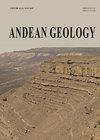Syn-Eruptive Taphoflora From The Agua De La Zorra Formation (Upper Triassic) Cuyana Basin, Mendoza, Argentina
IF 1.2
4区 地球科学
Q3 GEOLOGY
引用次数: 7
Abstract
In the North of Mendoza Province, at Paramillos de Uspallata locality, Triassic sedimentary rocks outcrop. These Triassic beds are grouped in four formations: Paramillos, Agua de la Zorra, Portezuelo Bayo and Los Colorados. The Agua de la Zorra Formation is characterized by deposition in a deltaic and lacustrine system. The aims of this contribution are: (1) to realize a systematic study of new plant remains found in the Agua de la Zorra Formation and (2) to analize the influence of the potential of preservation and the volcanism in the Agua de la Zorra taphoflora in contrast with other Triassic units. Plant remains were systematically collected and compared with taphofloras from other Triassic formations of the Cuyana Basin. The systematic study from the Agua de la Zorra Formation allowed the determination of 21 taxa, nine of which have been cited in a previous contribution and 12 were described for the first time for the Agua de la Zorra Formation. There are differences in the taxonomic diversity between the taphofloras recovered from Potrerillos and Paramillos formations and these differences are linking with differences in biostratinomic process in each fluvial system and linked with the evidence of volcanic processes in these areas. The differences in diversity in the taphofloras of the Cacheuta and Agua de la Zorra formations can be more associated to ecological differences than variations in the taphonomic processes in each of the lake systems.阿根廷门多萨圭亚那盆地上三叠统Agua De La Zorra组的同喷发型植物群
在门多萨省北部的Paramillos de Uspallata地区,三叠纪沉积岩露头。这些三叠纪地层分为四个地层:Paramillos、Agua de la Zorra、Portezuelo Bayo和Los Colorados。Agua de la Zorra组的特征是沉积在三角洲和湖泊系统中。这一贡献的目的是:(1)实现对在Agua de la Zorra组中发现的新植物遗骸的系统研究;(2)与其他三叠纪单元相比,分析Agua de la Zorra taphoflora的保存潜力和火山活动的影响。系统地收集了植物遗骸,并将其与库亚纳盆地其他三叠纪地层的taphofloras进行了比较。Agua de la Zorra组的系统研究确定了21个分类群,其中9个分类群已在以前的文章中被引用,12个分类群首次被描述为Agua de la Zorra地层。从Potrerillos和Paramillos地层中发现的taphofloras在分类多样性上存在差异,这些差异与每个河流系统的生物地层学过程的差异有关,并与这些地区火山作用的证据有关。Cacheuta和Agua de la Zorra组taphofloras多样性的差异可能更多地与生态差异有关,而不是与每个湖泊系统的taphonomic过程的变化有关。
本文章由计算机程序翻译,如有差异,请以英文原文为准。
求助全文
约1分钟内获得全文
求助全文
来源期刊

Andean Geology
地学-地质学
CiteScore
3.90
自引率
0.00%
发文量
17
审稿时长
>12 weeks
期刊介绍:
This journal publishes original and review articles on geology and related sciences, in Spanish or English, in three issues a year (January, May and September). Articles or notes on major topics of broad interest in Earth Sciences dealing with the geology of South and Central America and Antarctica, and particularly of the Andes, are welcomed.
The journal is interested in publishing thematic sets of papers and accepts articles dealing with systematic Paleontology only if their main focus is the chronostratigraphical, paleoecological and/or paleogeographical importance of the taxa described therein.
 求助内容:
求助内容: 应助结果提醒方式:
应助结果提醒方式:


